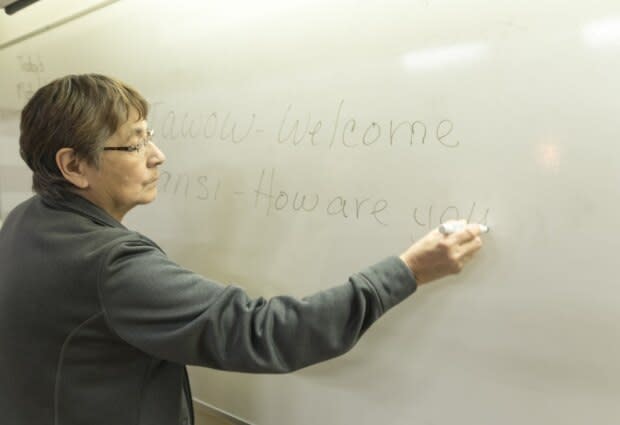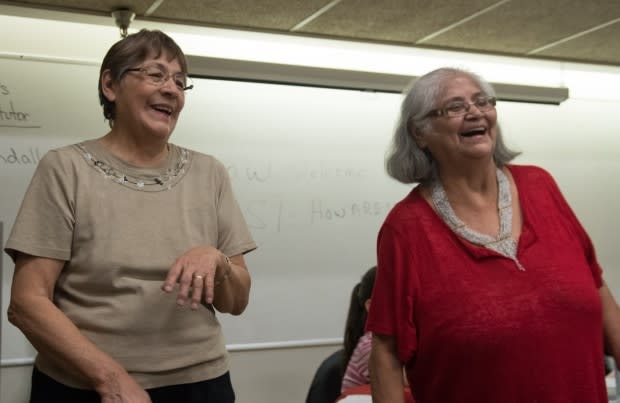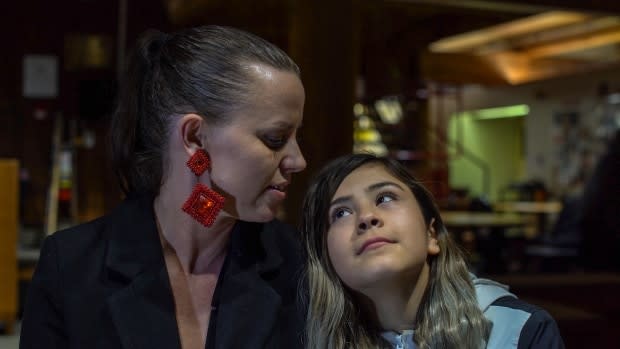Urban Cree reclaim their heritage by learning the most common Indigenous language in Metro Vancouver

In the unceded lands of the Musqueam, Squamish and Tsleilwaututh First Nations, the most commonly understood Indigenous mother tongue isn't Halkomelem. It's Cree, according to Statistics Canada.
Inside a warm classroom in East Vancouver's Native Education College (NEC) on a cold rain-slicked night, language instructor Dorothy Visser teaches her first lesson in Plains Cree to a packed classroom.
"Tawow," — welcome — Visser said. "Ta-wow," 40 students said in unison.
"Tansi," she continued. "Tansi," students responded — how are you? For the mostly Cree students, it's their first time speaking their mother-language.
More than 87 Indigenous languages in Canada are at risk of dying, according to a UNESCO report. But in this small Vancouver classroom, lessons are not only breathing life into Cree, they're instilling a sense of identity in people whose Cree homeland is east of the Rocky Mountains.
Learning Cree in the city
Back in the classroom, Visser and co-instructor Pauline Johnston put students through their paces with language exercises and a song.

There are five dialects of Cree. Visser and Johnston teach students the Y-dialect of Plains Cree, which Visser grew up speaking, she says.
Cree originated with the Algonquin people in Quebec and Ontario, and the language migrated west across Manitoba, Saskatchewan and Alberta, she said. Cree is also a relative to the Ojibway language, lessons in which are also taught at the Native Education College.
According to the. 2016 Census, Cree is listed as the most commonly understood Indigenous mother tongue in Metro Vancouver.
Visser is a study in language resilience and defiance. Her parents and grandparents spoke only Cree when she grew up. She retained her language in residential school. And she still retained it after spending 18 months in the hospital recovering from TB, away from her home on the Saddle Lake Cree Nation in central Alberta.
"I used to write home to my grandfather using the Cree syllabics," Visser said.
'To see her without shame and with pride': Cree mother weeps as her daughter who is learning the language beams
For Visser, 80, teaching the language at this stage of her life is about doing her part to heal an old wound. "So many have lost our language and have a sorrow because it was prevented from being spoken in residential school," she said. "It feels so good to see all these people eager to learn every week."
Her students — 36 women and four men — introduced themselves before the lesson. All had Cree ancestry, and nearly all said they wanted to reclaim their language.
I didn't know who I was
For student Dawn Johnson, learning Cree is instilling the identity that was taken away from her when she was placed in foster care as a child. "There was shame around my identity and Indigeneity. I learned to exist by being white-passing," said Johnson, who has a fair complexion.

Johnson says her daughter won't experience the same humiliation because she is learning about her identity and culture. "Growing up in the child care system, I didn't know who I was," said Johnson. "I see her with so much pride and so much strength in who she is as a Cree and Dene woman, I've never witnessed shame in her and that is healing," a teary-eyed Johnson said.
The 10-week program was founded by the Pacific Association of First Nations Women two years ago. The organizations' lead matriarch Diana Day said the group is applying for funding to host a Cree language immersion program, at which students would only speak Cree.
Women are the cornerstone of culture, Visser explained. "Women teach it to their children as mothers and they carry on the culture."
The Cree language classes are also underwritten with a grant from the First Peoples' Cultural Council. The Native Education College donates the classroom space.


